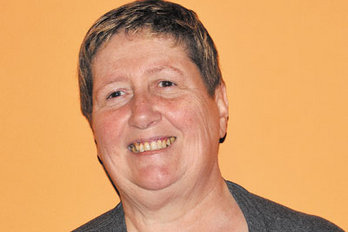Participant: Franny Price, executive director, Philadelphia Pride Presents; owner, Spruce Street Video
Age: 59 Starting weight: 264 Height: 5-foot-3 Weight lost to date: 55 pounds
PGN: Why did you decide to do Weigh It Forward? FP: A lot of people were worried about my weight — about me having a heart attack and flopping over. I thought the same people would pledge money per pound I lost. So, I would be raising money and, at the same time, it would be encouragement and a support mechanism because you are being watched.
PGN: What are you hoping to achieve? FP: I feel like I already achieved a lot of it. I’ve already changed my lifestyle, the way I eat and exercise. I have some personal goals: I’m going to have my first walk from my house to town. That will be my “Rocky” moment. It’s about 2.5 miles. And I’m going to go to Disney World and fit on The Mummy ride — I plan to do that this summer. I couldn’t fit in that seat before, three years ago.
PGN: What’s been your biggest struggle with your weight? FP: The inconveniences of being fat. One, when you go into a diner, and you look to see which side is bigger. Two, when you go on an airplane and have to ask for the extension. Three, I didn’t want to walk anywhere, I wanted to drive. Now I can just go out the door.
PGN: What’s been the hardest so far? FP: The only hard thing — and it’s not really hard; it’s because of my life — I can’t be consistent when I go to the gym. Sometimes I go in the morning, the afternoon or at night. I would really like to be in a routine. And sometimes working with the trainer is hard, but very educational.
PGN: The easiest? FP: Believe it or not, the food. Changing the way I eat hasn’t been as hard. Even though I just tried my first cleanse and this is day three. I’m on my third juice and I have three more to go. I’m not hungry, I just don’t like the taste of all of them.
PGN: Has anything surprised you? FP: How out of shape I really was. I didn’t realize I had no balance. Simple little things that are really important in everyday life. Knowing I wasn’t walking up the steps right. I have to learn to do everything all over again, including walking.
PGN: Tell me about your workout plan. FP: Cardio, a lot of cardio. I do all the cardio equipment, and do the ab machine and then whatever my trainer Jo-Ellen has me do, I try to do that two-three times a week. I go to the gym five-six days a week, never less than five. I try to change it up every week. This week, I’ve been going on the elliptical, then go over to the bike, then do the machines. Then the next day, do the treds and the bike. I do at least an hour of cardio, medium intensity.
PGN: And food? FP: I’m on a low-carb diet: I count my calories every day, and I’m eating less than 1,200. For sugars, I keep them at 28 grams per day. I put everything I eat into My Fitness Pal [mobile phone app], and it really does help. I’m also using Diet To Go: It was a big help in the first three-and-a-half months. It’s easy — the food is done for you. I was doing that for three meals a day, seven days a week.
PGN: Is this something you can sustain? FP: I know I’m going to sustain this. I already achieved my lifestyle changes. I’m going to be eating like this for the rest of my life and going to the gym so I can maintain it.
PGN: What do you think will be the hardest part to sustain afterward? FP: To me, June 10 is just the end of the fundraising: Everything is going to be the same as it is today, forever. I do want to thank everyone who participated. I’m really proud of the “Fat Pack.” We bonded another way: We can just share things with each other that we can’t share with everyone. It’s really even fun — hard work, but fun.
Jo-Ellen Marks, director of special projects and program development, Optimal Sport Health Clubs, 601 Walnut St.; www.optimalsportshealthclubs.com
PGN: What has your plan for Franny been? JM: The biggest priority has to be the function of the body, the way her body works. I know she has a large weight-loss goal. But for long term, I want her to move more and function properly. Daily tasks, such as climbing stairs, was not easy for her. I focus on daily tasks and then get her heart rate up. I got her to work with her body weight, which improves function in her spine.
PGN: Tell me more about the exercise. JM: We use battling ropes, TRX, kettle bells to keep her body in motion. In addition to that, we increase her heart rate and burn more calories. She does one day a week with me for an hour, then four-five additional days a week on cardio and weight-bearing cardio. What Franny is working on now is improving her speed and distance. She’ll walk a mile, get on the bike, go up and down the stairs. If she did five times last week, she’ll do six times this week.
PGN: Tell me more about the food plan. JM: For food, Franny has been doing Diet To Go. They deliver two times a week. It’s a caloric restriction, freshly prepared foods. They have needed components for people to be healthy, high-quality carbohydrates. [Dietian] Colleen [DeCesare] went to work on her attitude about food, why you eat certain things, the psychosocial, emotional components. For lifelong change for health and fitness, people won’t be successful if they never work on why they do things. For Franny, it was really about getting honest, getting responsible about the amount of time she moved every week. She went all out — no excuses.
PGN: What results are you looking for short-term? JM: No. 1 is increasing frequency of exercise and get her into a regular fitness program. Second, to improve her behavior. Third, to lose weight. She set a goal of 50 pounds, she already passed that. Now, she wants to lose 60 pounds [by June 10].
PGN: And long-term? JM: Lifestyle behavior modification. If anybody has a fitness goal, if it’s not sustainable, you are setting them up to fail. If you don’t set someone up with realistic goals, you are doing them an injustice. You have to make small changes and keep making improvements on this. When she hits 70 pounds, 80, 90, then 100 — that’s her goal. I want her to maintain her health for the rest of her life. My commitment to her is that she gets a lifelong fitness and nutrition program that works for her and keeps her healthy.

